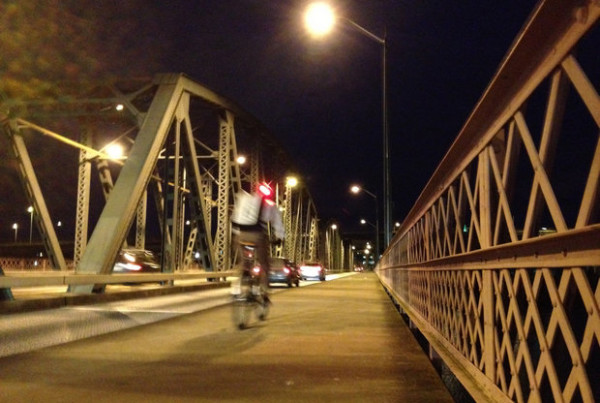The Coloradoan: Trends and lessons emerge from review of Fort Collins bike, car crashes
By Nate Taylor
Fort Collins officials say newly compiled and detailed statistics categorizing specific types of bike vs. car crashes reveal one overriding lesson: There’s room for all commuters to improve their behavior.
“It’s clear looking at this data there is room for improvement for both motorists and bicyclists,” Fort Collins Traffic Engineer Joe Olson said. “Everyone has accountability for making everyone safe.”
Olson and his staff spent about a month’s time compiling the data categorizing bike and car crashes by poring through Fort Collins police crash reports from Jan. 1, 2007, through June 30, 2009. Less detailed statistics also were compiled for reports since 2000, categorizing crashes by noninjury, injury and fatalities.
Reported bike crashes have steadily increased in Fort Collins since 2003, and the most common type of collision reported by far since 2007 is when bicyclists are traveling against traffic and end up in a broadside collision with a car.
The inaugural compilation of the data also revealed that broadside collisions account for more than half of the 25 fatal or severe injury crashes reported since 2007.
There were four fatal crashes between 2000 and June of 2009 — one in 2000, one in 2004, two in 2008 — and in the second half of this year, the city endured one more bicyclist fatality.
The total number of crashes, as well as injury crashes, were fairly consistent between 2000 and 2003, but in 2004, the city saw an increase that has continued year after year with the exception of 2006.
The lowest number of bike and car crashes in Fort Collins since 2000 was in 2001 when there were 102. The highest number was in 2008 when there were 142 crashes.
In 2009, the city is on pace to match the 2008 total.
One thing the data does not account for is the number of cyclists on the road. Olson said there’s no way to come up with concrete ridership numbers. Although Fort Collins bike coordinator Dave “DK” Kemp said the American Community Survey estimates bicycle commuters made up about 5 percent of the city’s population in 2006, growing to 7.4 percent in 2008.
“We’re on the way to the point where motorists can expect to see bicycles everywhere,” Kemp said.
The data, which has already been presented to some city staff members and the city’s citizen transportation advisory board, is intended to finally provide some concrete facts about what is happening on the roads in order to better aid with education efforts and engineering decisions, Olson said.
“We’re trying to identify educational opportunities bicyclists can do to ride safer and motorists can look for,” Olson said. “We want to use this as a tool, either via education or through physical changes to the streets.”
Broadsides are predominant issue
There were 354 bike vs. car crashes from Jan. 1, 2007, through June 30, 2009. About 60 percent of those crashes, or 214, were categorized by city engineers as “broadside” collisions.
Broadsides are defined as any crash when a bicyclist hits or is hit by a car on a perpendicular road.
The most common broadside crash occurs when the bicyclist is riding against traffic, which occurred 123 times, or about four times per month during the 30 months of data compilation.
The Fort Collins statistics put to rest what was once a common belief that the overtaking turn, or “right hook,” was the most common crash.
“There aren’t as many as we generally thought,” said Kemp of the overtaking turn crashes.
Compared to broadside collisions, the overtaking turns accounted for about 13 percent, or 46, of the crashes.
Kemp said the data about the broadside collisions indicate bicyclists need to be driving on the correct side of the road, and drivers need to be on the lookout.
“That really tells us the general message is to start seeing bicycles everywhere,” he said. “We need to really put it in the motorists’ minds that they really need to be looking out for bicyclists.”
The crash classified as a “sideswipe” collision, where an opposite or same direction of travel crash occurs, happened 26 times, accounting for about 7 percent of crashes. Both of the fatalities in 2008 fell into this category.
The fatality in the second half of 2009, which is not accounted for in the data, would have been classified as a broadside collision.
Most dangerous crossings
At age 62, Bill Jenkins is an avid bicyclist, and each day, he rides to and from work down Shields Street and turns onto Plum Street, a block north of one of the most dangerous intersections in Fort Collins: Shields and Elizabeth streets.
The intersection is one of a handful of intersections in Fort Collins that Olson and his staff have identified as crossings where nine or more bike vs. car crashes have occurred since Jan. 1, 2007.
“I can see why,” said Jenkins, a member of the city’s citizen transportation advisory board. “I’ve gone through there a few times and it’s just a hard intersection with all the bikes, cars and the lights there.”
Plum and Elizabeth streets are major roads for the thousands of CSU students who walk, ride and drive to campus from apartments and homes just west of campus.
Kemp said a map the city built reflecting Old Town and the campus west areas as the most dangerous in the city reaffirm the belief that Colorado State University students are a group that would benefit greatly from education efforts.
The Plum and Elizabeth intersections are also spots where not only education efforts but engineering changes could benefit bicyclists. Kemp said the crossings are prime spots for a “bike box,” or a colored bike lane at the front of an intersection where vehicles are required to wait behind bicycles until a light turns green.
Olson said the bike box, which is used in cities such as Portland, Ore., is something Fort Collins is considering implementing.
Jenkins said he’d be receptive to the idea of creating bike boxes throughout the city.
“When you use the bicycle box, that will raise the consciousness of drivers to another level,” he said. “It would certainly make the drivers more aware of what’s going on.”
Educational opportunities
After moving from Seattle to Fort Collins within the past year, 31-year-old Brian Kerin said he was hopeful he’d be encountering a bike-friendly environment.
Unfortunately, he said, his experiences on the roads have been filled with drivers angry at bicyclists.
“It just appears to me there was a general understanding in Seattle that bikes are allowed to be on the roads, and I don’t see that here,” Kerin said.
Kemp and Jenkins both said they hope the recently compiled bike crash data will further efforts to inform both drivers and bicyclists.
“We’re excited to see this data. We are beginning to mature as a bicycle culture in terms of our ability to get along out there,” Kemp said. “We have a pretty ingrained bike culture in terms of a lot of people doing it, but in terms of respect on the road, we’re sort of in our infancy.”
Jenkins said he thinks the data will help bike advocacy groups get on the same page about what issues need to be addressed through education.
“We can emphasize the real problems,” he said. “My experience with different bike groups is that everyone has their favorite bad thing to emphasize. This will kind of focus everyone.”
Kerin, who works at Fort Collins Brewery and frequently bikes to work through Old Town, said he hopes education efforts reach bicyclists as much as drivers.
Kemp said the city plans to incorporate the city’s data into education efforts and into the 2010 updated city bike maps.
“There’s no one out there that thinks bikes are the angels of the road,” he said. “There’s a lot of bad bike behavior and a lot of bad car behavior.”

